*This post may contain affiliate links. Read more »
Red lentil dahl is an excellent choice for a quick, easy weeknight meal requiring minimal effort and cleanup. This flavorful gluten-free Indian dish is made with red lentils, herbs, and fragrant medicinal spices, all cooked together in a single pot. The lentils add protein and fiber to the dish, while the turmeric, cumin, cinnamon, and coriander provide a rich and warming flavor.
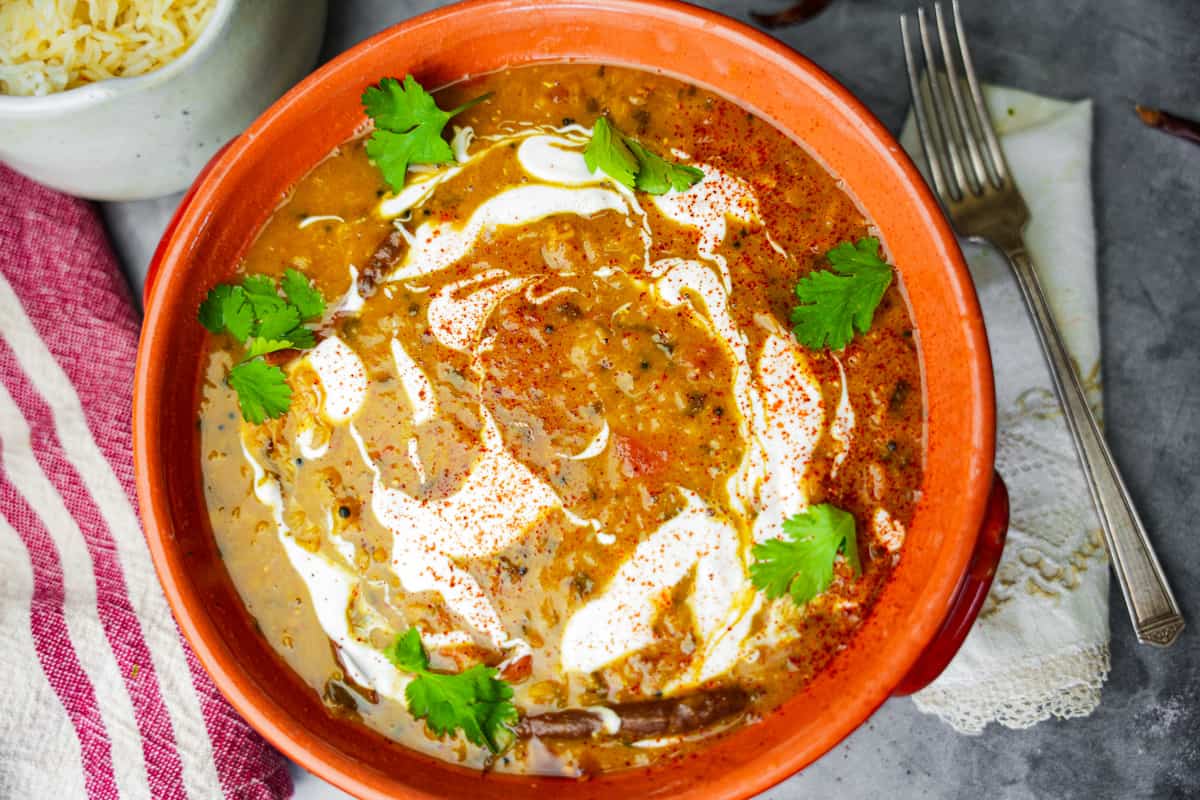

Enter your email & I'll send it to your inbox. Plus, get great new recipes from me every week!
By submitting this form, you consent to receive emails from Cinnamon Snail.
Nothing nourishes and soothes like a steaming warm bowl of this flavorful dahl. My kids grew up eating rice and dahl as their go-to comfort food, and still love when I make it for them almost every week. I purposefully make this dahl without onions and garlic, but if you would like up the aromatics, just add a clove of minced garlic and half a diced onion to the pot while you are initially sautéing the spices.
With its comforting flavors and dead-easy preparation, red lentil dahl is a perfect choice for a delicious and nutritious weeknight dinner! It is a match made in heaven if you serve with flaky Kerala parotta over a hot bowl of my veggie-packed sattvic veg biryani, or alongside my tender, juicy vegan butter chicken. If you want a great sabji to serve with this, a great option is my completely sattvic Peerkangai Kootu (South Indian ridge gourd curry). If sattvic dahl isn't your thing, you might want to check out my recipe for North Indian Arhar Dal (toor dal) or Morocan Harira which also has chickpeas and vermicelli in a tastefully spiced tomato broth.
So whatcha waiting for? Grab your favorite soup pot, or instant pot and let’s get your kitchen smelling like heaven!
Jump to:
🥰Why you'll love this red dahl recipe
🍲 One-Pot Wonder: Savor a satisfying meal with minimal cleanup.
❄️ Freezes well: Keep this dahl on hand for an easy-to-thaw nourishing meal anytime you don't feel like cooking.
🥘 Crockpot Perfection: You can make this in a regular pot on the stove, or a pressure cooker, and it is also great for for crockpot or instant pot cooking.
🧘♂️Suddha sattva: A completely sattvic dish—no onions, garlic, meat, or eggs. Perfect for yogis and devotees. If you are new to sattvic cuisine, check out my other sattvic recipes, or check out my whole sattvic vegan cooking class!


🤘Learn to make flawless prasadam
This guide to my most popular sattvic vegan recipes is 100% FREE, & you'll love the actual heck out of it 🥰
🍅 Ingredeints
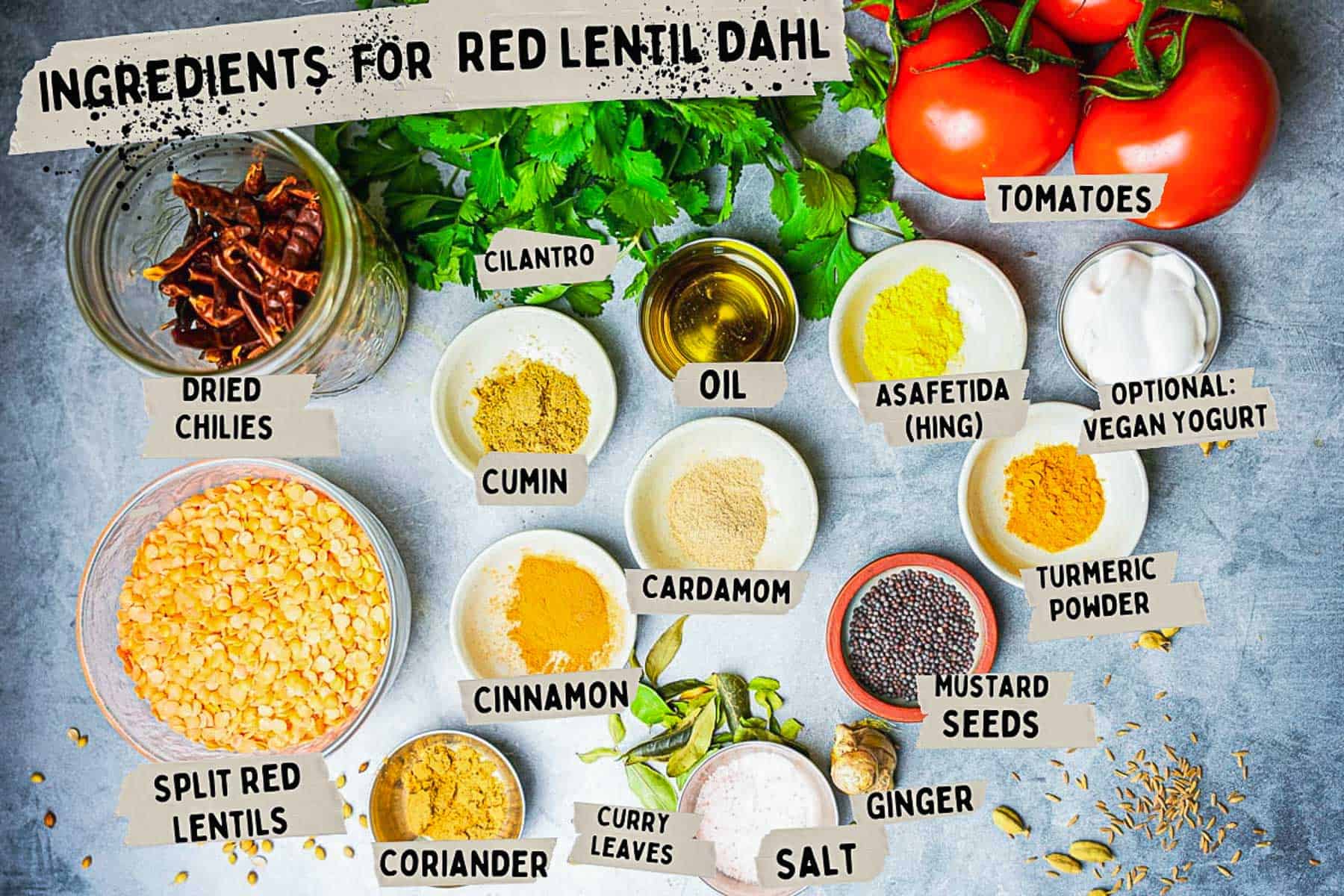
Asafetida
Asafetida (also known as hing) is a pungent spice that is commonly used in Indian cuisine to add depth and flavor to dishes. It is made from the dried resin extracted from the roots of the Ferula plant and has a distinct aroma that is often described as similar to garlic or onions. I recommend using asafetida powder rather than the crystalized resin block form, which can be trickier to measure and deal with.
Split red lentils
These are great for soups (I also use them in my vegan carrot lentil soup and Lebanese lentil soup too) because they cook so quickly!
Curry leaves
One of the most wonderful aromas you can get in your kitchen comes from cooking curry leaves! I use 'em in my chana dal and parval curry recipes. You can pick them up at most Indian grocery stores, or grow your own as a house plant! They are fairly easy to keep alive and happy.
Mustard seeds
Not all dahl recipes use them, but I love the nutty flavor of freshly popped mustard seeds in my dahl. The best flavor comes from medium or large brown mustard seeds.
Cardamom
Cardamom comes in green and black varieties. My favorite pre-ground green cardamom is the cloud forest cardamom from Burlap and Barrel. It is really an exceptionally flavorful coarsely ground spice!
📖 How to make this traditional Indian dal recipe
You wanna see how this yummy thing gets made? I will walk you through the whole quick process. Or you can follow along with the easy-to-print recipe card towards the bottom of this page.
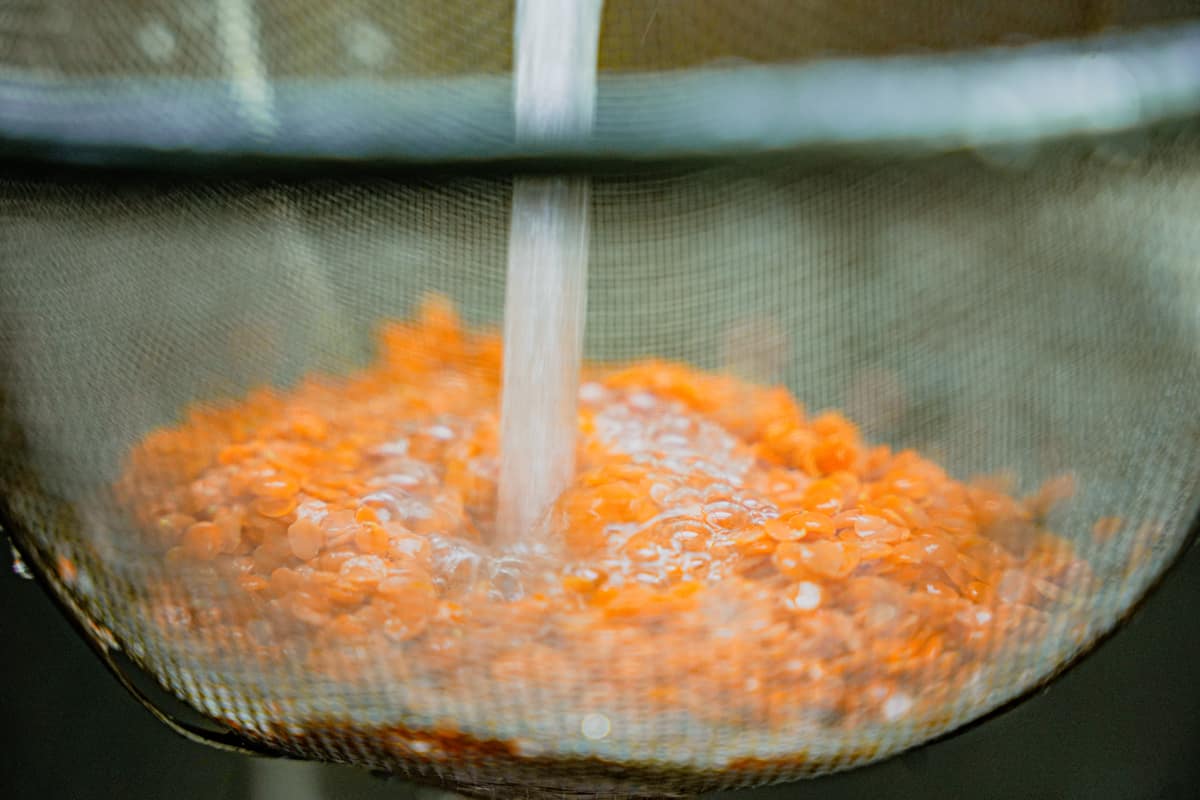
Step 1
Rinse and pick through the red lentils to ensure they are completely free of foreign contaminants.
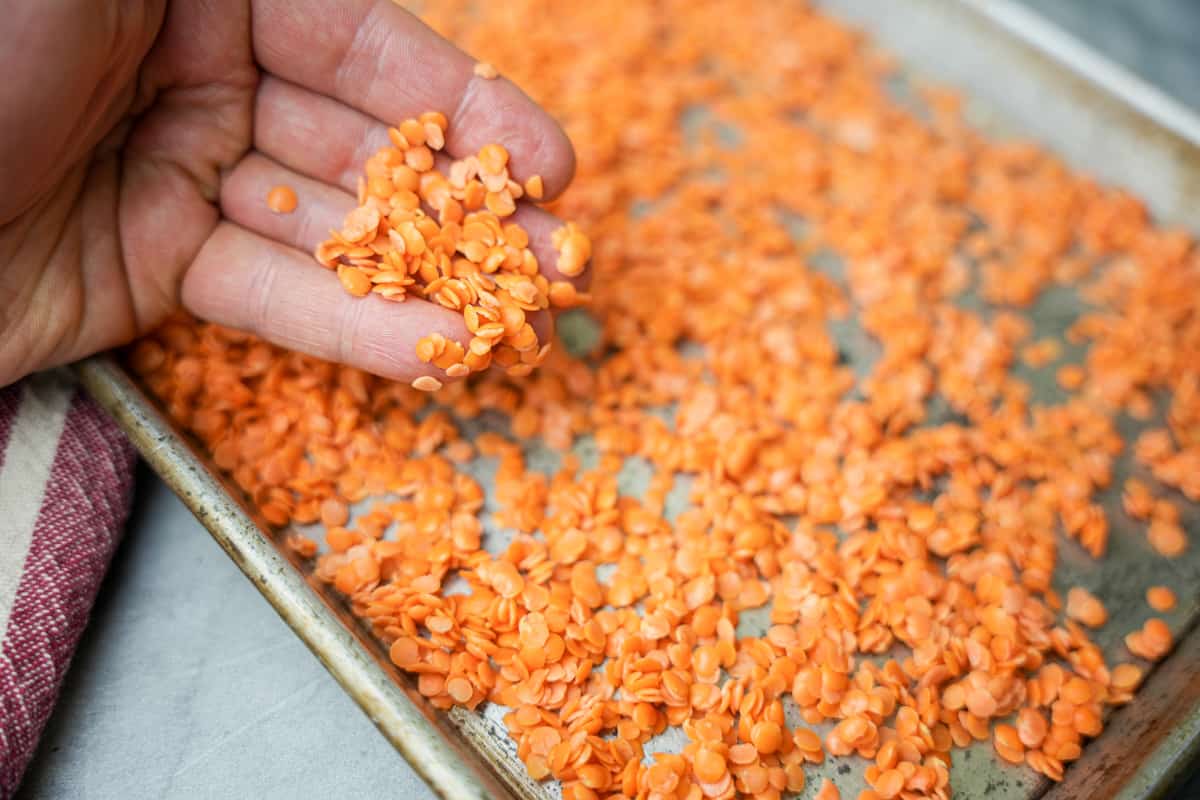
Step 2
Sort through the drained lentils and make sure there are no stones or miff-maff (is that a word?) that didn't come out when rinsed.
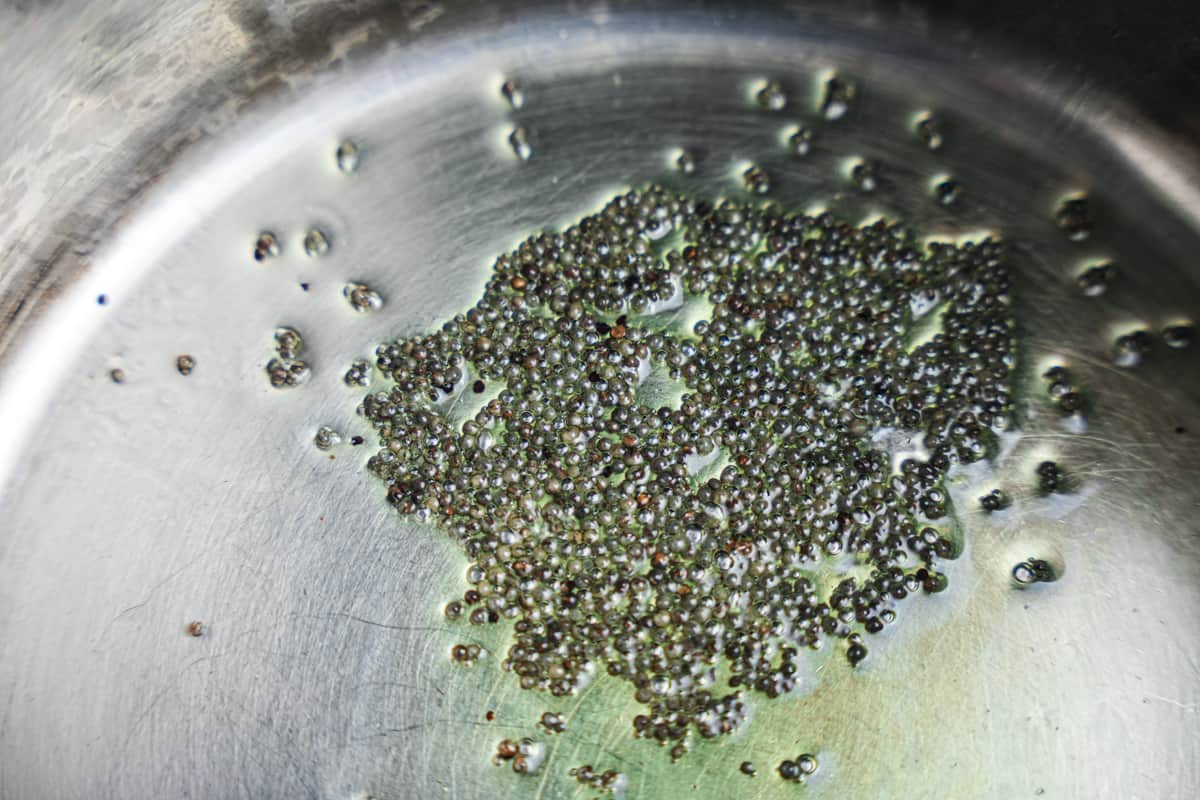
Step 3
Pop mustard seeds in hot oil over high heat.

Step 4
Stir in the chilies, spices, salt, and ginger, and turn the heat down to medium.
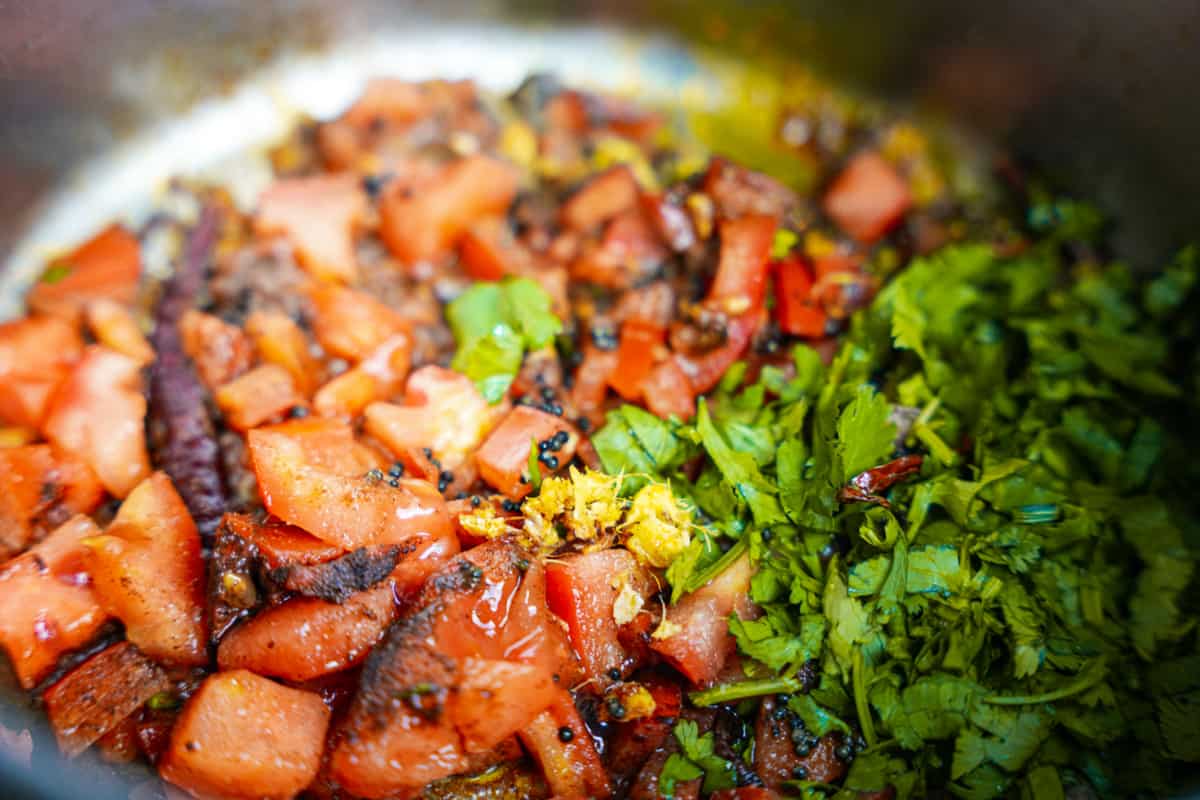
Step 5
After about 90 seconds, when the spices are fragrant, add the diced tomato, curry leaves, and cilantro. Sauté for 3-4 minutes until the tomatoes start to break down a bit.
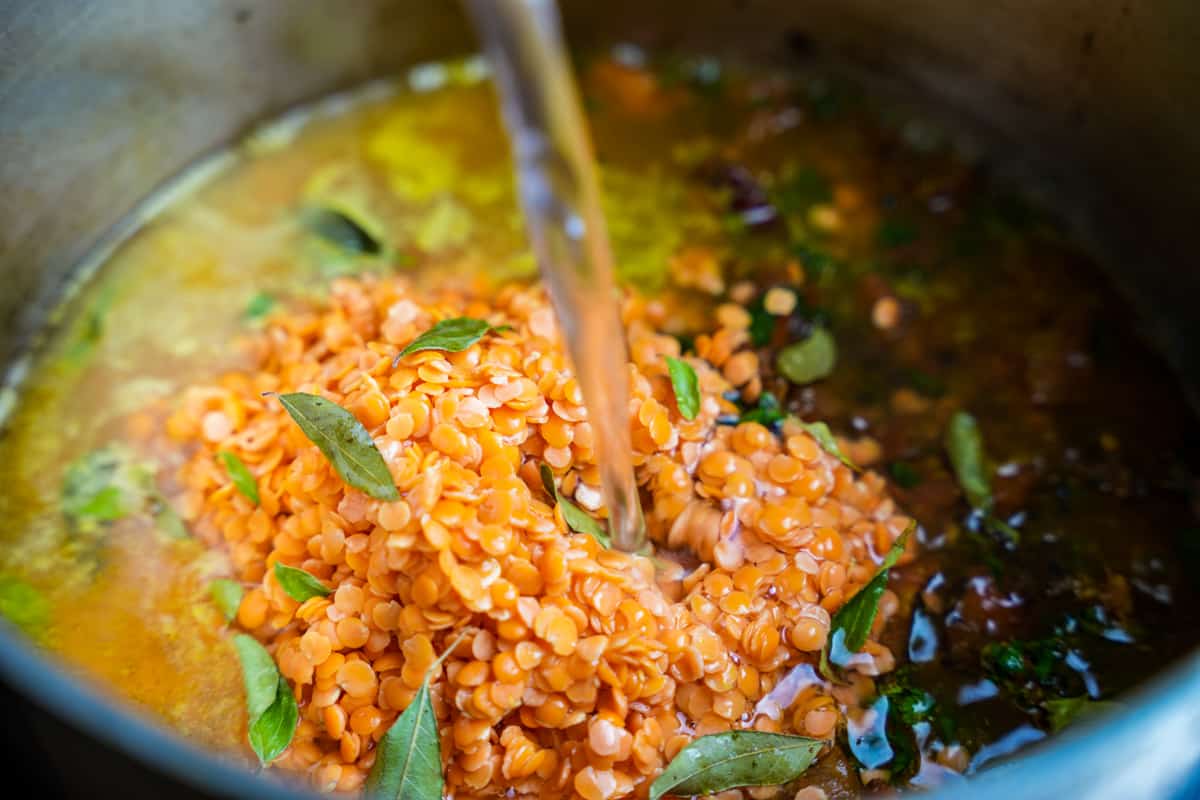
Step 6
Add the red lentils and the water or broth. Bring the pot up to a boil.
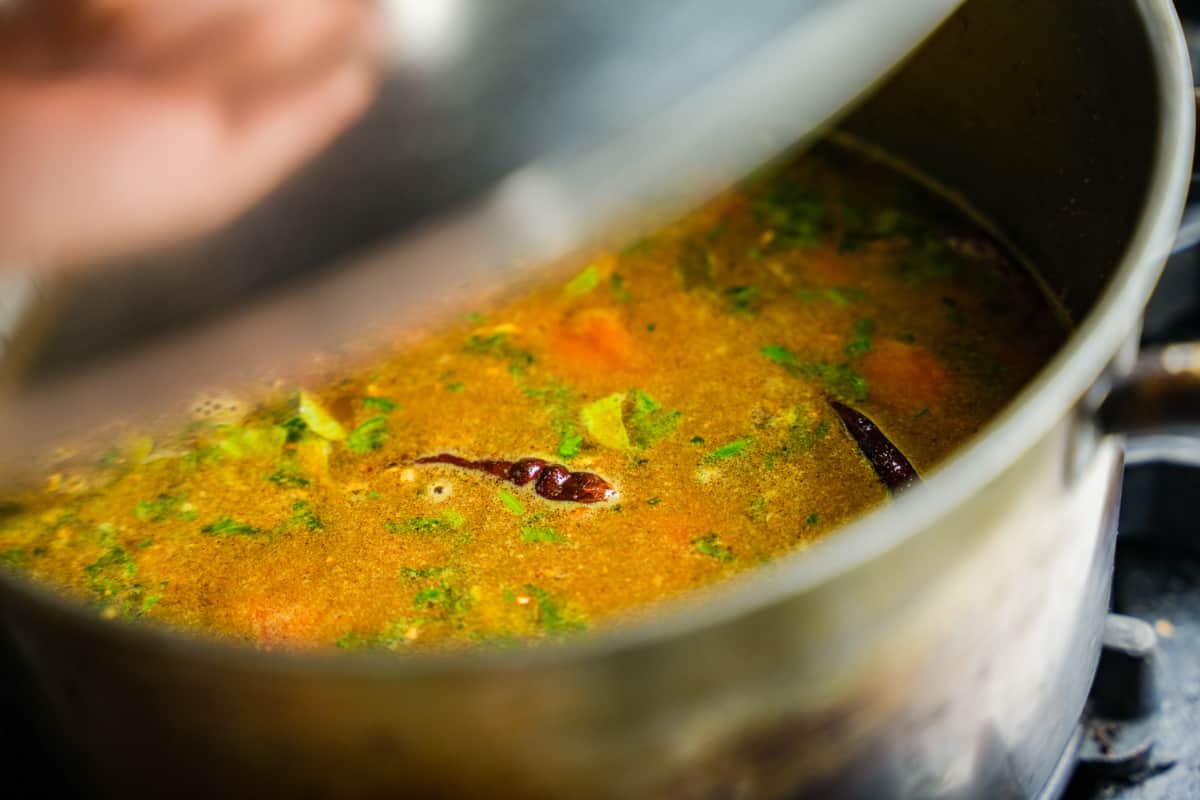
Step 7
Once the contents of the pot are boiling, place a lid on the pot and lower the flame to a simmer. Cook the dahl for 60-75 minutes covered, until the lentils start to fall apart.
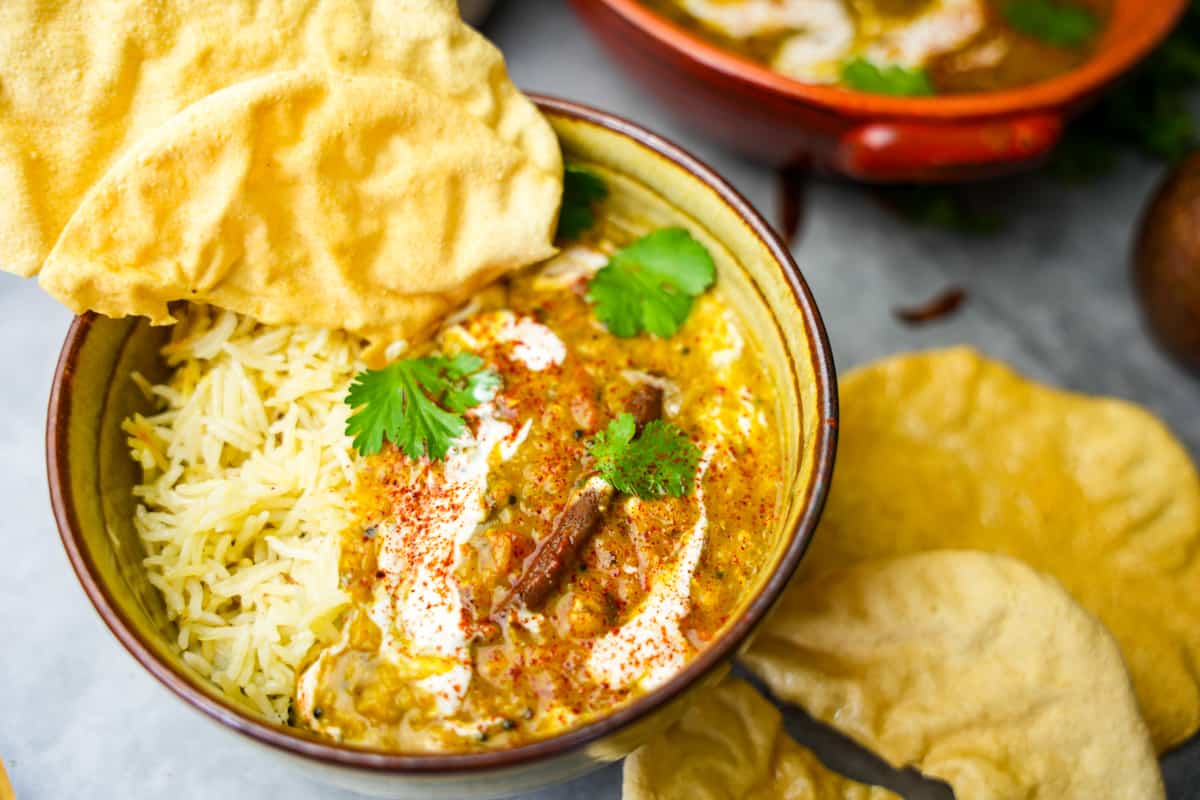
Step 8
To serve, pour the dahl into an attractive serving bowl. Swirl in a few spoonfuls of unsweetened vegan yogurt if desired, lightly dust with Kashmiri red chili powder, and garnish with fresh cilantro leaves.
Instead of yogurt, you could also swirl in a little of my easy-to-make homemade vegan labneh. It's nice to eat the dahl over coconut rice, or alongside some freshly grilled Parotta, Kuboos, potato kulcha, or flaky Msemen.
🍽️ Serving Suggestions
Serve with your favey chaats like phool makhana masala, shakarkandi ki chaat, or onion bhaji.
Serve it with chickpea dishes like dry black chana, or North Indian-style chole.
Other dishes that you could serve as sides to this dahl are Punjabi dry bhindi, saag aloo, and lauki sabji.
I love serving dal with pickles such as amlaki, mango pickle, yamagobo, carrot pickles, or spicy hari mirch pickles!
🪷How to modify dahl to suit your ayurvedic dosha
Red lentil Dahl can be prepared in accordance with Ayurvedic principles for the three different doshas (Vata, Pitta, and Kapha) by adjusting the spices and ingredients used in the recipe. Here are some guidelines for preparing red lentil Dahl for each dosha:
For Vata Dosha:
- Use warming spices such as ginger, cumin, coriander, and cinnamon to balance the cold and dry qualities of Vata.
- Add some diced root vegetables such as carrot, beet, or parsnip to make it more grounding.
- Serve the Dahl warm or hot, and avoid eating it too late in the evening.
For Pitta Dosha:
- Use more cooling herbs such as coriander, fennel, mint, and cilantro to balance the heat and intensity of Pitta.
- Use a smaller amount of spices, and avoid using too much chili or hot peppers.
- Add cooling vegetables such as cucumber or zucchini to the Dahl to make it more refreshing and hydrating.
For Kapha Dosha:
- Use more warming and stimulating spices such as ginger, black pepper, red pepper flakes, and mustard seeds to balance the heavy and sluggish qualities of Kapha.
- Add light and pungent vegetables such as kale, spinach, or radish to the Dahl to make it more cleansing and detoxifying.
- A spoonful of shatta sauce mixed in.
- Avoid using too much oil, and serve the Dahl warm or hot to stimulate digestion.
If you would like to learn more about Ayurveda and how to identify your dosha, Vasant Lad’s Ayurvedic Institute has some great online resources!
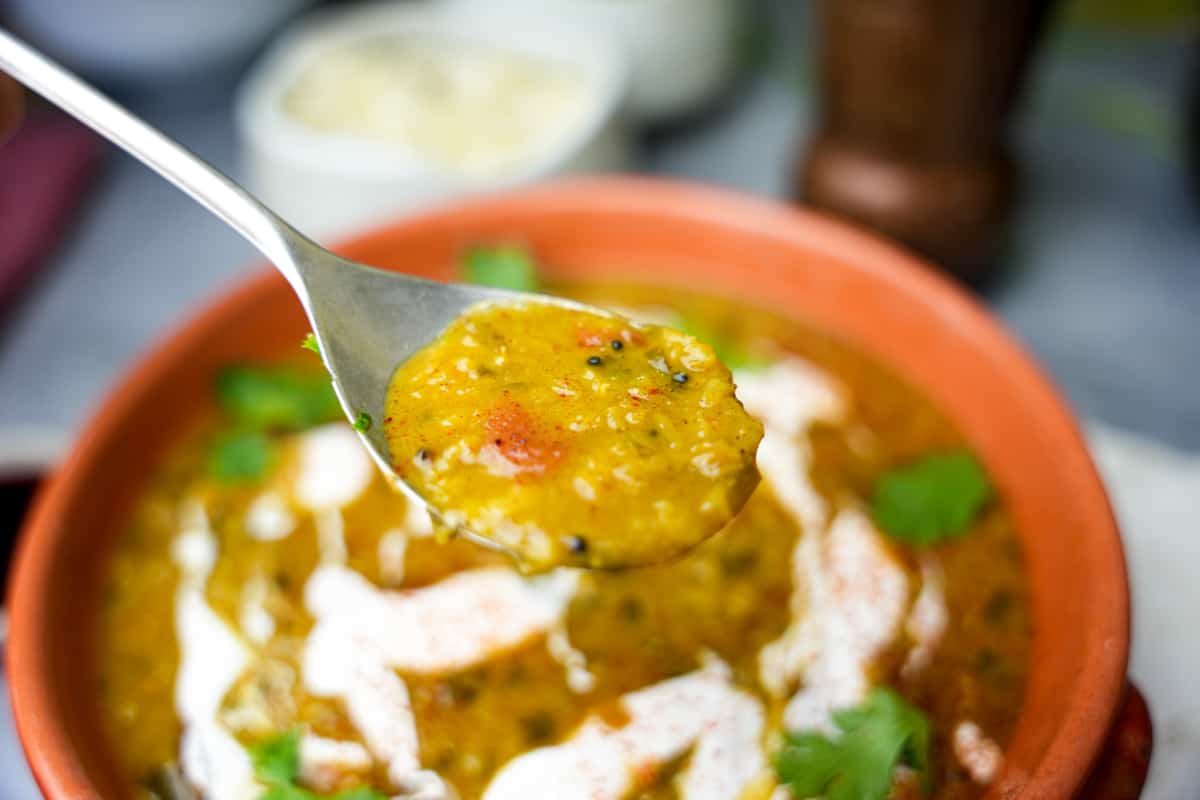
❗️Top tips
To emulate the dahl you get in restaurants (if that’s your thing), you can consider the following tweaks-
Restaurants tend to use much more fat in cooking. The extra oil helps coat your tongue when you are eating, which can make the flavors pop more and feel richer. So feel free to increase the oil if you want that restaurant-style dahl.
You can also consider adding some tamarind paste to your dahl. Tamarind lends a subtly sweet and sour dimension to the dahl that can enliven the flavor of some of the other spices and herbs. I would suggest using 1 ½ teaspoons of tamarind paste in this recipe if you have some on hand.
To get a more intense flavor from your spices, use whole spices instead of pre-ground ones. Toast the whole spices for a couple of minutes in a dry pan over medium heat and then grind them in a spice grinder or mortar and pestle before using them in this recipe.
🤷♀️Recipe FAQs
Some dal can contain foreign contaminants like pebbles, glass or agricultural matter. To ensure the dal is safe to eat you should follow these steps:
Sort the dal: Spread the dal out on a flat surface like a baking pan or cutting board with a gutter and remove any small stones, debris, or discolored lentils.
Rinse the dal: Rinse the sorted dal under running water 2-3 times or until the water runs clear. Use a mesh strainer or colander with holes smaller than the size of the dal to drain the water.
Soak the dal (optional): Soaking for 30 minutes can help to soften the lentils and make them easier to cook. Drain the water after soaking.
Pick through the dal: Spread the rinsed and soaked dal on a flat surface and pick through it carefully with your fingers. Look for any foreign objects such as small stones, twigs, or pieces of dirt, and remove them.
Rinse the dal again: Rinse the picked dal under running water once more to remove any remaining debris or dust.
Drain the dal: Use a colander to drain the water from the dal and use as needed.
It's important to note that picking through dal is essential to ensure that foreign contaminants are removed. Skipping this step could result in consuming foreign objects, which can be harmful to health.
Red lentil dahl, also known as dal or daal, is a vegetarian Indian dish made with red lentils and various spices. It is typically served with rice or bread and is a popular dish in Indian cuisine. The split red lentils (a.k.a. masoor dal) break down quickly, making this a great choice for a quick meal. There are some other kinds of dal you can make this recipe with, which I have listed below.
The dish is made by cooking red lentils with spices like cumin, coriander, cinnamon, turmeric and ginger. Sometimes garam masala, hing, or curry powder are used. They are simmered with water or broth until they are soft and creamy. Other ingredients like onions, garlic, drumstick, and tomatoes are often added to enhance the flavor.
The final result is a thick, hearty stew-like dish that is packed with protein and nutrients. Red lentil dahl is a delicious and healthy choice for vegans, vegetarians and non-vegetarians.
Dahl stays good for up to four days if stored properly.
Allow the dahl to cool down to room temperature.
Transfer the dahl to an airtight container.
Place the container in the refrigerator if you plan to consume it within 3-4 days.
If you plan to store it for longer than 3-4 days, transfer the dahl to the freezer (on day ONE, not when it's already tasting old...)
❄️To freeze cooked dahl, follow these steps:
Allow the dahl to cool down to room temperature.
Transfer the dahl to a freezer-safe container or freezer bag.
Label the container or bag with the name and date of the dish.
Place the container or bag in the freezer.
🧥To thaw frozen dahl, follow these steps:
Remove the container or bag of dahl from the freezer.
Place it in the refrigerator and allow it to thaw overnight.
🔥Reheating:
Once thawed, reheat the dahl in a saucepan over medium heat, stirring occasionally until it is heated through. Alternatively, you can reheat the dahl in the microwave by placing it in a microwave-safe dish and heating it on high for 1-2 minutes, stirring halfway through.
It's important to note that the texture of the dahl may change slightly after freezing and thawing. You may find it becomes slightly more watery or the lentils become slightly softer. However, the flavor should remain relatively unchanged.
The sattvic diet in the Vedic tradition emphasizes the consumption of prasadam- sanctified food which has been offered to the Supreme.
Ingredients that are considered rajasic (stimulating, or in the mode of passion) or tamasic (dull, lethargic, or in the mode of ignorance) should be avoided. This means that onions, garlic, meat, alcohol, and rancid or mildly toxic ingredients are avoided, as they are considered impure and can affect the mind and body negatively.
The process for preparing bhoga (food to be enjoyed by Bhagavan) involves first physically and spiritually purifying oneself and the kitchen, using fresh and pure ingredients, and preparing the food with love and devotion. Sattvic food should not be tasted while being prepared. The food is then offered to the divine, either through prayer, or directly to an altar before being consumed, and is believed to have a purifying effect on the mind and body.
Sattvic foods are light, easily digestible, and nutrient-dense, making them ideal for promoting physical and mental health. Examples of sattvic foods include fresh fruits and vegetables, whole grains, legumes, nuts, and seeds. Most fresh ingredients in a vegan diet are considered sattvic unless they are prepared in a way that becomes overly stimulating to the senses, or harmful to the body.
Overall, the sattvic diet and the process of offering bhoga and consuming prasadam are important aspects of the Vedic tradition. By consuming pure and nourishing foods and offering them to the divine with love and devotion, we can promote physical, mental, and spiritual health, and cultivate a deeper connection with the Supreme.
If you are on an oil-free diet, you will be delighted to know that this recipe can be easily made without oil! I recommend cooking it in a well-seasoned dutch oven or non-stick pot. Just cook the spices, tomato, and ginger while constantly stirring to prevent them from burning before you add the liquid ingredients.
Press the "Sauté" button on your Instant Pot and wait for it to heat up.
Add oil to the inner pot and allow it to heat up.
Add the mustard seeds, and wait about 60 seconds until they pop rapidly.
Stir in the chilies, spices, salt, and ginger.
Once the spices are fragrant, add the tomato, curry leaves and cilantro, and sauté, stirring regularly for 3-4 minutes until the diced tomatoes start to break down.
Add the rinsed dahl and water, or broth
When you're ready to slow cook, turn off the sauté function and set your Instant Pot to the desired cooking setting.
Most Instant Pots do not have a specific "simmer" function, but they do have a "Slow Cook" function that can be used to cook dahl on a low heat setting for an extended time. Using the Slow Cook function, you can set the Instant Pot to cook dahl for 4-6 hours on the low heat setting, which should result in a creamy and flavorful dahl.
However, if you are looking to cook dahl quickly, the Instant Pot's pressure cooking function can significantly reduce the cooking time. Depending on the type of dahl, cooking it under high pressure in an Instant Pot can take as little as 8-12 minutes, which is much faster than cooking it on the stove for an hour.
Dried chilies-
You can totally use a dried Mexican chili such as arbol in dahl, but for a more authentic flavor, here are a few chilies you can seek out us use in dahl and other Indian recipes:
Kashmiri chili: an Indian red chili with mild-medium heat. Kashmiri chili has a gorgeous bright red color, which is due to the high levels of capsaicinoids, and carotenoids present in the pepper. These compounds not only give the chili its distinctive hue but also provide numerous health benefits, including anti-inflammatory and antioxidant properties. It has a sweet and smoky taste, with a hint of fruitiness that sets it apart from other chili peppers.
Guntur chili: grown in the Guntur district of Andhra Pradesh in India, it is known for its super-high heat level and is commonly used in dishes from the region. It is essential to making gongura pachadi: a tangy and spicy chutney made with gongura (sorrel) leaves, guntur chilies, and other spices.
Byadagi chili: Byadagi is grown in the state of Karnataka, where I used to go every year to spend time in Mysore. It has a mild to medium heat level and is often used for its vibrant red color as well as its flavor. I also use them in my Aviyal and Ridge Gourd Curry.
I created this recipe with split red lentils (masoor dal), a readily available option in North America. Other quick-cooking dahls that work well include:
Toor Dal: Common in South Indian cooking, it has a mild, nutty flavor. Also known as Tovar Dal in Northern India and Arhar Dal in parts of Central India. I have a whole arhar dal recipe you can follow!
Chana Dal: Made from split chickpeas, it's common in North Indian cooking. Takes a bit longer to cook than masoor dal, so allow 30-40 extra minutes if using chana dal or yellow split peas. Here is a sattvic chana dal recipe you can check out!
Yellow Split Peas: Different from chana dal, made from dried, hulled yellow peas. Has a mild flavor and is more easily available in western supermarkets.
Split Moong Dal: Made from split mung beans, used in both North and South Indian cooking. Has a mild, slightly sweet flavor and is versatile for various dishes.
Urad Dal: Made from split black lentils, common in North Indian cooking. White urad works for making medhu vadai. It has a rich, earthy flavor and cooks fast.
Beluga Lentils: Not traditional for dal but adds a unique touch. Small and dark, they won't break down as much, giving a delicious texture to the final dish.
✌️Sattvic recipes to serve with red lentil dahl:
Say Hi on Social! 👋
Follow me on Instagram & Facebook for more recipes.
❤️Love this recipe? It helps me out greatly if you leave a 5-star 🌟🌟🌟🌟🌟rating in the recipe card below and maybe even leave me a lovey-dovey comment too!
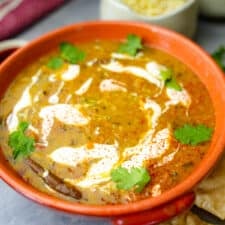
red lentil dahl (sattvic masoor dal)
Ingredients
- 1 tablespoon olive oil
- 1 teaspoon mustard seeds
- 1 tablespoon minced ginger
- 2 dried hot chilies or more to taste
- 1 teaspoon toasted cumin seeds
- 1 teaspoon ground coriander
- ½ teaspoon hing asafoetida powder
- ½ teaspoon turmeric powder
- ½ teaspoon ground cardamom
- ½ teaspoon cinnamon
- 1 teaspoon salt or to taste
- 1 medium tomato diced
- 12 curry leaves optional
- ⅓ cup minced cilantro
- 4 cups unsalted vegetable broth or water
- 1 cup split red lentils masoor dal, rinsed and picked through.
Optional to garnish
Instructions
- Thoroughly wash and sort through the red lentils to ensure they are free from foreign contaminants. Set the clean lentils aside to drain in a mesh strainer.
- Heat the oil in a pot over high heat. This usually takes around 60 seconds, depending on how thick the metal of your pot is. Once the oil is hot, add the mustard seeds and cook them until they pop and sputter rapidly.
- Add the ginger, diced chilies, aromatic spices, and salt to the pot and reduce the heat to medium. Stir the ingredients together and cook for approximately 90 seconds until the spices become fragrant and emit their aroma.
- After the spices are fragrant, add the diced tomato, curry leaves, and cilantro. Sauté the mixture for about 3-4 minutes until the tomatoes begin to break down.
- Add the red lentils along with the water or broth into the pot.
- Once the mixture has reached a boil, cover the pot with a lid and reduce the heat to a simmer. Let the dahl cook for 60-75 minutes, opening the lid to stir occasionally, until the lentils become tender and start to fall apart. If you want a smoother dahl, you can cook it longer (up to 2 hours), adding water as needed to keep it from drying out or becoming too thick.
- When the dahl is fully cooked, transfer it to an attractive serving bowl. If desired, stir in a couple of spoonfuls of unsweetened vegan yogurt or full-fat coconut milk. Lightly dust the dahl with Kashmiri red chili powder for an extra kick, and garnish with fresh cilantro leaves to elevate the flavor and add a pop of color.
Notes

Enter your email & I'll send it to your inbox. Plus, get great new recipes from me every week!
By submitting this form, you consent to receive emails from Cinnamon Snail.

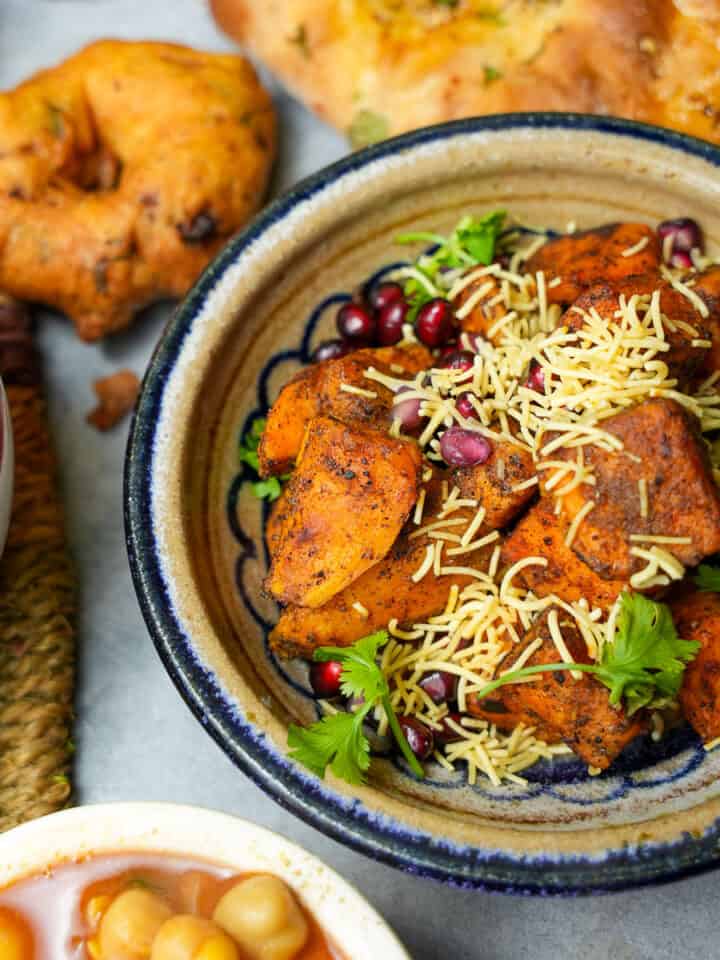
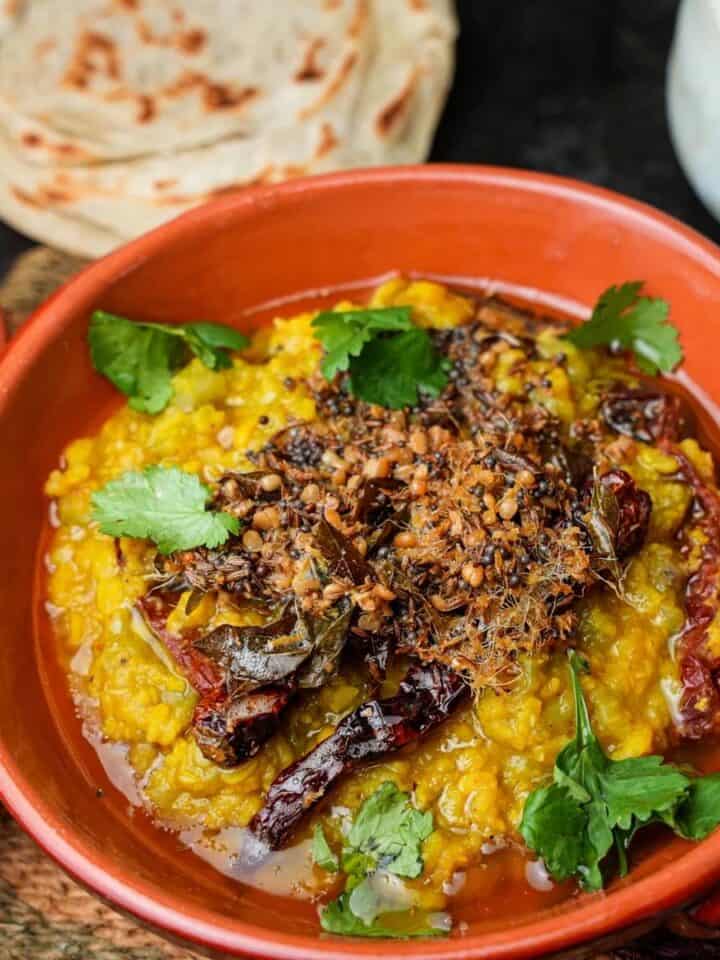

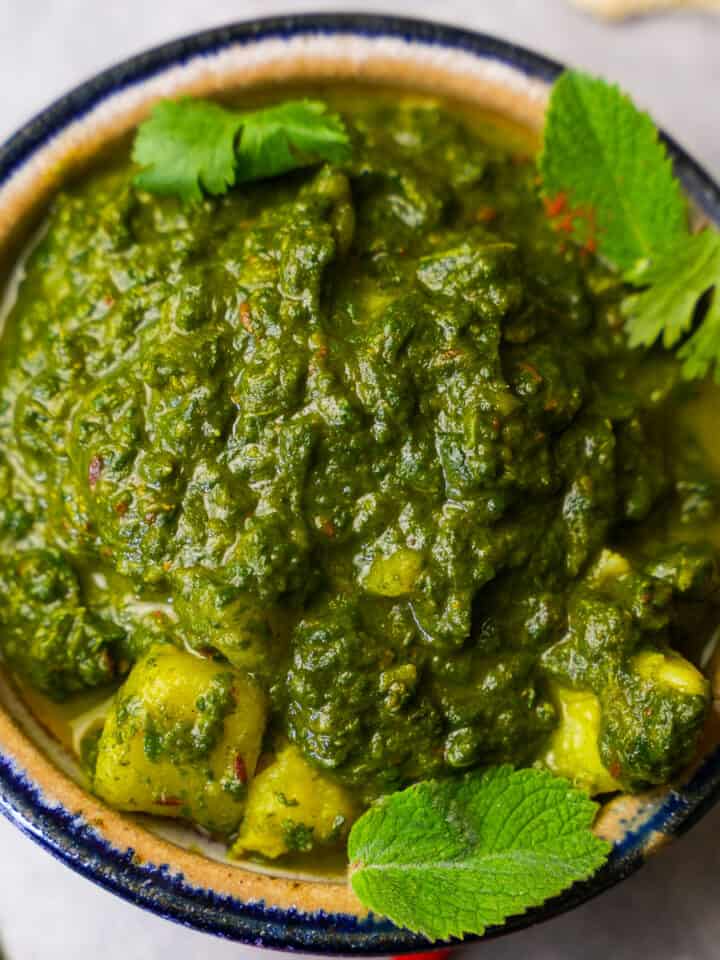




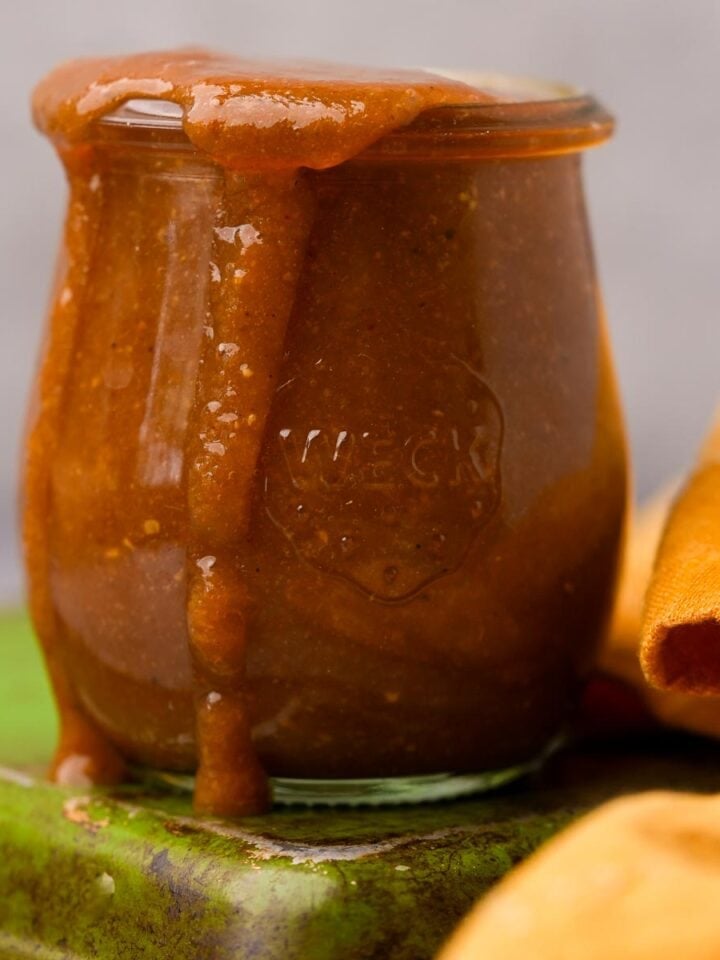
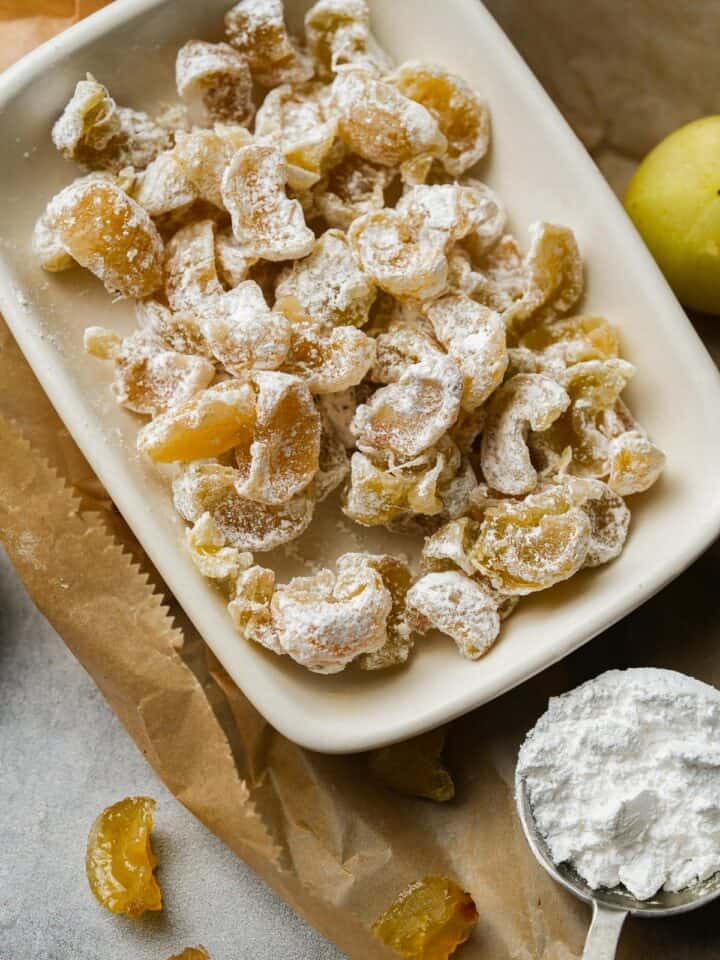
Meg says
Ok well I had a brain “blockage” and used toor dali stead of red lentils. I can report it was completely wonderful.
I didn’t have yoghurt, so chopped up extra fresh tomato—it just cried out for some extra “sweetness” (wrong word but that fresh high note) that would have come with the yoghurt, and maybe with the red lentils that tend to have a sweeter taste. And coriander. Fed it to my farm raised meat eating friends with a jackfruit curry and your Amritsari Kulcha. Very happy people and no-one was killed in the process.
Thank you Chef Adam for yet another triumph. I’ll be repeating this over and over. So easy, so tasty.
Sage says
Perfection! Perfect balance of spices. I did add finally shopped Dino kale (can't help myself). I'm using it as a spread on naan with cucumber and tomato and roasted veg. I also oven roast carrots, purple sweet potato and red pepper in coconut oil with garam masala and ras el hanut. Really great vegan sandwich.
So grateful to have found you Adam!! So many fantastic recipes. Going through these offering will last for years!
All blessings and many thanks.
Sage
Adam Sobel says
So glad you loved it Sage. I also can't help myself with adding kale to stuff. I have said for years to my kids that "greens are the meat of a vegan diet." Nothing leaves me feeling as satisfied and great.
Heva says
I recently tried this Red Lentil Dahl recipe and it was absolutely delicious! It had the perfect combination of spices, and the red lentils were cooked to perfection. It's definitely one of my favorite recipes now!
Adam Sobel says
Yipee! If you like this one, you might also enjoy the Arhar Dal recipe I have in the blog. It has got a different, but also wonderful flavor.
Kat says
I've never made dahl quite like this and it was incredible. Definitely worth seeking out the curry leaves if you can, they add fantastic flavor. Had to fight over the leftovers!